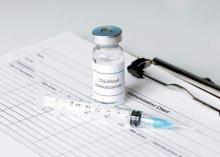User login
Endologix announces FDA approval of AFX2 Bifurcated Endograft
The U.S. Food and Drug Administration has approved the AFX2 Bifurcated Endograft System for the treatment of abdominal aortic aneurysms (AAA), the device’s manufacturer, Endologix, announced in a statement.
Endologix also touts the AFX2 as a way to facilitate percutaneous endovascular aneurysm repair (EVAR) by providing low-profile contralateral access through a 7F introducer. The device incorporates Endologix’s ActiveSeal technology, DuraPly expanded polytetrafluoroethylene graft material, and the Vela proximal endograft.
The AFX2 is expected to hit the market in the United States in the first quarter of 2016.
The U.S. Food and Drug Administration has approved the AFX2 Bifurcated Endograft System for the treatment of abdominal aortic aneurysms (AAA), the device’s manufacturer, Endologix, announced in a statement.
Endologix also touts the AFX2 as a way to facilitate percutaneous endovascular aneurysm repair (EVAR) by providing low-profile contralateral access through a 7F introducer. The device incorporates Endologix’s ActiveSeal technology, DuraPly expanded polytetrafluoroethylene graft material, and the Vela proximal endograft.
The AFX2 is expected to hit the market in the United States in the first quarter of 2016.
The U.S. Food and Drug Administration has approved the AFX2 Bifurcated Endograft System for the treatment of abdominal aortic aneurysms (AAA), the device’s manufacturer, Endologix, announced in a statement.
Endologix also touts the AFX2 as a way to facilitate percutaneous endovascular aneurysm repair (EVAR) by providing low-profile contralateral access through a 7F introducer. The device incorporates Endologix’s ActiveSeal technology, DuraPly expanded polytetrafluoroethylene graft material, and the Vela proximal endograft.
The AFX2 is expected to hit the market in the United States in the first quarter of 2016.
One-third of children with mental health conditions see PCPs only
Primary care providers (PCPs) in the United States saw more children with ADHD than did psychiatrists or psychologists/social workers for pediatric mental health care, as 35% of children with mental health conditions (and 42% of children with ADHD) saw only a PCP, according to research published online in Pediatrics.
L. Elizabeth Anderson of the University of Tennessee in Memphis and her associates used data from the Medical Expenditure Panel Survey from 2008-2011. The study sample comprised 1,778 children aged 2-21 years, all of whom had had outpatient mental health visits during the previous year. ADHD and anxiety/mood disorders combined to account for 87.9% of the conditions for which children received care.
One-quarter (23.8%) of all patients were managed by more than one provider, 6.7% were managed by both a PCP and a psychiatrist, 34.8% saw only a PCP, 26.2% saw only a psychiatrist, and 15.2% saw only a psychologist or social worker.
Management by more than one type of provider occurred for 20.2% of children with ADHD and 27.7% of children with anxiety/mood disorders. Children seen by a PCP were at least as likely or more likely to be prescribed psychoactive medications than were those seen by psychiatrists (70.2% vs 63.0%). Less wealthy and non–English-speaking families were significantly more likely to be managed by a PCP than a psychiatrist, although both groups were less likely to be prescribed medication for ADHD.
“These data support the importance of enhancing PCPs’ capacity for mental health care through collaborative care models, which have been shown to improve mental health outcomes relative to community care, as well as other strategies, such as expanding reimbursements beyond face-to-face visits,” the authors wrote.
The authors had no disclosures. Read the article here.
Primary care providers (PCPs) in the United States saw more children with ADHD than did psychiatrists or psychologists/social workers for pediatric mental health care, as 35% of children with mental health conditions (and 42% of children with ADHD) saw only a PCP, according to research published online in Pediatrics.
L. Elizabeth Anderson of the University of Tennessee in Memphis and her associates used data from the Medical Expenditure Panel Survey from 2008-2011. The study sample comprised 1,778 children aged 2-21 years, all of whom had had outpatient mental health visits during the previous year. ADHD and anxiety/mood disorders combined to account for 87.9% of the conditions for which children received care.
One-quarter (23.8%) of all patients were managed by more than one provider, 6.7% were managed by both a PCP and a psychiatrist, 34.8% saw only a PCP, 26.2% saw only a psychiatrist, and 15.2% saw only a psychologist or social worker.
Management by more than one type of provider occurred for 20.2% of children with ADHD and 27.7% of children with anxiety/mood disorders. Children seen by a PCP were at least as likely or more likely to be prescribed psychoactive medications than were those seen by psychiatrists (70.2% vs 63.0%). Less wealthy and non–English-speaking families were significantly more likely to be managed by a PCP than a psychiatrist, although both groups were less likely to be prescribed medication for ADHD.
“These data support the importance of enhancing PCPs’ capacity for mental health care through collaborative care models, which have been shown to improve mental health outcomes relative to community care, as well as other strategies, such as expanding reimbursements beyond face-to-face visits,” the authors wrote.
The authors had no disclosures. Read the article here.
Primary care providers (PCPs) in the United States saw more children with ADHD than did psychiatrists or psychologists/social workers for pediatric mental health care, as 35% of children with mental health conditions (and 42% of children with ADHD) saw only a PCP, according to research published online in Pediatrics.
L. Elizabeth Anderson of the University of Tennessee in Memphis and her associates used data from the Medical Expenditure Panel Survey from 2008-2011. The study sample comprised 1,778 children aged 2-21 years, all of whom had had outpatient mental health visits during the previous year. ADHD and anxiety/mood disorders combined to account for 87.9% of the conditions for which children received care.
One-quarter (23.8%) of all patients were managed by more than one provider, 6.7% were managed by both a PCP and a psychiatrist, 34.8% saw only a PCP, 26.2% saw only a psychiatrist, and 15.2% saw only a psychologist or social worker.
Management by more than one type of provider occurred for 20.2% of children with ADHD and 27.7% of children with anxiety/mood disorders. Children seen by a PCP were at least as likely or more likely to be prescribed psychoactive medications than were those seen by psychiatrists (70.2% vs 63.0%). Less wealthy and non–English-speaking families were significantly more likely to be managed by a PCP than a psychiatrist, although both groups were less likely to be prescribed medication for ADHD.
“These data support the importance of enhancing PCPs’ capacity for mental health care through collaborative care models, which have been shown to improve mental health outcomes relative to community care, as well as other strategies, such as expanding reimbursements beyond face-to-face visits,” the authors wrote.
The authors had no disclosures. Read the article here.
FROM PEDIATRICS
FRONTIER screen distinguishes frontotemporal dementia from Alzheimer’s
Researchers who administered the FRONTIER Executive Screen (FES) – a brief bedside questionnaire designed to assess verbal fluency, inhibitory control, and working memory – were able to distinguish patients with behavioral-variant frontotemporal dementia (bvFTD) from patients with Alzheimer’s disease, according to a study published in the Journal of Neurology, Neurosurgery & Psychiatry.
“FES correctly classified over 90% of study participants into healthy controls or patients with dementia (bvFTD and AD). Within patient groups, almost three-quarters of patients with dementia were correctly classified into bvFTD and AD based on the total FES score,” wrote the researchers, led by Olivier Piguet, Ph.D., of Neuroscience Research Australia, New South Wales.
They administered the FES to 28 patients with dementia (14 with bvFTD, 14 with Alzheimer’s disease) matched for disease severity and 33 age-matched healthy controls. After adjustment, they found that a cut-off FES total score of 7 or below achieved 71% sensitivity and 73% specificity for a diagnosis of bvFTD. While the researchers noted that the screen demonstrated excellent discriminative validity from distinguishing the two groups of patients, they warned that the test is not designed to replace a comprehensive cognitive assessment, and assessing executive dysfunction in other clinical populations using the FES is not recommended.
“Our findings indicate that the combination of the FES with the [Addenbrooke’s Cognitive Examination–III] will improve discriminative ability between dementia syndromes; however, this result will need to be demonstrated in prospective studies. Future research will also benefit from exploring the utility of administering the FES, in conjunction with social cognition measures, with evidence that such measures can also assist with differentiating bvFTD from AD, and bvFTD from psychiatric conditions,” the researchers wrote.
They indicated that they had no conflicts of interest.
Read the full article here.
Researchers who administered the FRONTIER Executive Screen (FES) – a brief bedside questionnaire designed to assess verbal fluency, inhibitory control, and working memory – were able to distinguish patients with behavioral-variant frontotemporal dementia (bvFTD) from patients with Alzheimer’s disease, according to a study published in the Journal of Neurology, Neurosurgery & Psychiatry.
“FES correctly classified over 90% of study participants into healthy controls or patients with dementia (bvFTD and AD). Within patient groups, almost three-quarters of patients with dementia were correctly classified into bvFTD and AD based on the total FES score,” wrote the researchers, led by Olivier Piguet, Ph.D., of Neuroscience Research Australia, New South Wales.
They administered the FES to 28 patients with dementia (14 with bvFTD, 14 with Alzheimer’s disease) matched for disease severity and 33 age-matched healthy controls. After adjustment, they found that a cut-off FES total score of 7 or below achieved 71% sensitivity and 73% specificity for a diagnosis of bvFTD. While the researchers noted that the screen demonstrated excellent discriminative validity from distinguishing the two groups of patients, they warned that the test is not designed to replace a comprehensive cognitive assessment, and assessing executive dysfunction in other clinical populations using the FES is not recommended.
“Our findings indicate that the combination of the FES with the [Addenbrooke’s Cognitive Examination–III] will improve discriminative ability between dementia syndromes; however, this result will need to be demonstrated in prospective studies. Future research will also benefit from exploring the utility of administering the FES, in conjunction with social cognition measures, with evidence that such measures can also assist with differentiating bvFTD from AD, and bvFTD from psychiatric conditions,” the researchers wrote.
They indicated that they had no conflicts of interest.
Read the full article here.
Researchers who administered the FRONTIER Executive Screen (FES) – a brief bedside questionnaire designed to assess verbal fluency, inhibitory control, and working memory – were able to distinguish patients with behavioral-variant frontotemporal dementia (bvFTD) from patients with Alzheimer’s disease, according to a study published in the Journal of Neurology, Neurosurgery & Psychiatry.
“FES correctly classified over 90% of study participants into healthy controls or patients with dementia (bvFTD and AD). Within patient groups, almost three-quarters of patients with dementia were correctly classified into bvFTD and AD based on the total FES score,” wrote the researchers, led by Olivier Piguet, Ph.D., of Neuroscience Research Australia, New South Wales.
They administered the FES to 28 patients with dementia (14 with bvFTD, 14 with Alzheimer’s disease) matched for disease severity and 33 age-matched healthy controls. After adjustment, they found that a cut-off FES total score of 7 or below achieved 71% sensitivity and 73% specificity for a diagnosis of bvFTD. While the researchers noted that the screen demonstrated excellent discriminative validity from distinguishing the two groups of patients, they warned that the test is not designed to replace a comprehensive cognitive assessment, and assessing executive dysfunction in other clinical populations using the FES is not recommended.
“Our findings indicate that the combination of the FES with the [Addenbrooke’s Cognitive Examination–III] will improve discriminative ability between dementia syndromes; however, this result will need to be demonstrated in prospective studies. Future research will also benefit from exploring the utility of administering the FES, in conjunction with social cognition measures, with evidence that such measures can also assist with differentiating bvFTD from AD, and bvFTD from psychiatric conditions,” the researchers wrote.
They indicated that they had no conflicts of interest.
Read the full article here.
FROM JOURNAL OF NEUROLOGY, NEUROSURGERY & PSYCHIATRY
Intravenous immunoglobulin briefly staved off progression to Alzheimer’s
Intravenous immunoglobulin (IVIG) appears to delay the progression of mild cognitive impairment to Alzheimer’s disease, but the effect is short lived, based on the results of a double-blind study of 50 patients published in the Journal of Neurology, Neurosurgery and Psychiatry.
Dr. Shawn Kile of the Sutter Neuroscience Institute in California and his colleagues assessed 50 participants, aged 50-84 years with amnestic mild cognitive impairment. The patients were administered either 0.4 g/kg of 10% IVIG or 0.9% saline every 2 weeks for a total of five infusions (2 g/kg total dose). Patients’ levels of neurodegeneration were assessed using the Mini-Mental State Examination, the Alzheimer’s Disease Assessment Scale-cognitive subscale, and the Clinical Dementia Rating-Sum of Boxes scale.
At 12 months, 58% of the patients in the placebo group and 33% of those in the IVIG group had converted to Alzheimer’s dementia. At the 24-month follow-up, 72% of cases in the IVIG group and 75% in the placebo group had progressed to dementia.
The observed effect of IVIG was strongest for participants in the earliest stages of mild cognitive impairment, suggesting that early intervention is optimal for slowing cognitive decline, the investigators wrote.
Read the full article here: (J Neurol Neurosurg Psychiatry. 2015 doi: 10.1136/jnnp-2015-311486).
Intravenous immunoglobulin (IVIG) appears to delay the progression of mild cognitive impairment to Alzheimer’s disease, but the effect is short lived, based on the results of a double-blind study of 50 patients published in the Journal of Neurology, Neurosurgery and Psychiatry.
Dr. Shawn Kile of the Sutter Neuroscience Institute in California and his colleagues assessed 50 participants, aged 50-84 years with amnestic mild cognitive impairment. The patients were administered either 0.4 g/kg of 10% IVIG or 0.9% saline every 2 weeks for a total of five infusions (2 g/kg total dose). Patients’ levels of neurodegeneration were assessed using the Mini-Mental State Examination, the Alzheimer’s Disease Assessment Scale-cognitive subscale, and the Clinical Dementia Rating-Sum of Boxes scale.
At 12 months, 58% of the patients in the placebo group and 33% of those in the IVIG group had converted to Alzheimer’s dementia. At the 24-month follow-up, 72% of cases in the IVIG group and 75% in the placebo group had progressed to dementia.
The observed effect of IVIG was strongest for participants in the earliest stages of mild cognitive impairment, suggesting that early intervention is optimal for slowing cognitive decline, the investigators wrote.
Read the full article here: (J Neurol Neurosurg Psychiatry. 2015 doi: 10.1136/jnnp-2015-311486).
Intravenous immunoglobulin (IVIG) appears to delay the progression of mild cognitive impairment to Alzheimer’s disease, but the effect is short lived, based on the results of a double-blind study of 50 patients published in the Journal of Neurology, Neurosurgery and Psychiatry.
Dr. Shawn Kile of the Sutter Neuroscience Institute in California and his colleagues assessed 50 participants, aged 50-84 years with amnestic mild cognitive impairment. The patients were administered either 0.4 g/kg of 10% IVIG or 0.9% saline every 2 weeks for a total of five infusions (2 g/kg total dose). Patients’ levels of neurodegeneration were assessed using the Mini-Mental State Examination, the Alzheimer’s Disease Assessment Scale-cognitive subscale, and the Clinical Dementia Rating-Sum of Boxes scale.
At 12 months, 58% of the patients in the placebo group and 33% of those in the IVIG group had converted to Alzheimer’s dementia. At the 24-month follow-up, 72% of cases in the IVIG group and 75% in the placebo group had progressed to dementia.
The observed effect of IVIG was strongest for participants in the earliest stages of mild cognitive impairment, suggesting that early intervention is optimal for slowing cognitive decline, the investigators wrote.
Read the full article here: (J Neurol Neurosurg Psychiatry. 2015 doi: 10.1136/jnnp-2015-311486).
FROM THE JOURNAL OF NEUROLOGY, NEUROSURGERY AND PSYCHIATRY
Shoulder strength is impaired in women with early-stage RA
In women, shoulder function is reduced early in the course of rheumatoid arthritis, based on a study published in Arthritis Research & Therapy.
At a mean of 20 months after diagnosis, women with rheumatoid arthritis (RA) had impaired shoulder muscle strength and shoulder-arm movement, and more shoulder pain, as compared to matched women without RA.
Lead author Dr. Annelie Bilberg of the University of Gothenburg in Sweden and her associates examined 103 women with rheumatoid arthritis and a reference group of 103 age-matched healthy women in a controlled cross-sectional study. Pain during shoulder and arm movements was assessed by the Borg symptom scale, and isometric muscle strength of the shoulder abductor muscles was assessed with an ISOBEX 3.0 dynamometer. Activity limitations were assessed using the Disabilities of the Arm, Shoulder and Hand (DASH) questionnaire. Physical workload did not significantly differ between the patient and control groups.
At the time of the assessment, 53% of the patients and 20% of the controls reported shoulder symptoms. Shoulder muscle strength in the patient group was about 65% of that in the control group, and patients’ hand-grip force was approximately 55% of that in the controls. DASH questionnaire results averaged 25.7 in the patient group and 2.6 in the control group. All of the differences were statistically significant.
Shoulder function, emphasizing shoulder muscle strength, should be assessed at disease onset, the researchers advised. A prospective follow-up study of shoulder function in patients with new-onset RA would help to explain the natural progression of the disease.
Read the full article here: Arthritis Care and Research 2015. doi:10.1186/s13075-015-0777-0.
In women, shoulder function is reduced early in the course of rheumatoid arthritis, based on a study published in Arthritis Research & Therapy.
At a mean of 20 months after diagnosis, women with rheumatoid arthritis (RA) had impaired shoulder muscle strength and shoulder-arm movement, and more shoulder pain, as compared to matched women without RA.
Lead author Dr. Annelie Bilberg of the University of Gothenburg in Sweden and her associates examined 103 women with rheumatoid arthritis and a reference group of 103 age-matched healthy women in a controlled cross-sectional study. Pain during shoulder and arm movements was assessed by the Borg symptom scale, and isometric muscle strength of the shoulder abductor muscles was assessed with an ISOBEX 3.0 dynamometer. Activity limitations were assessed using the Disabilities of the Arm, Shoulder and Hand (DASH) questionnaire. Physical workload did not significantly differ between the patient and control groups.
At the time of the assessment, 53% of the patients and 20% of the controls reported shoulder symptoms. Shoulder muscle strength in the patient group was about 65% of that in the control group, and patients’ hand-grip force was approximately 55% of that in the controls. DASH questionnaire results averaged 25.7 in the patient group and 2.6 in the control group. All of the differences were statistically significant.
Shoulder function, emphasizing shoulder muscle strength, should be assessed at disease onset, the researchers advised. A prospective follow-up study of shoulder function in patients with new-onset RA would help to explain the natural progression of the disease.
Read the full article here: Arthritis Care and Research 2015. doi:10.1186/s13075-015-0777-0.
In women, shoulder function is reduced early in the course of rheumatoid arthritis, based on a study published in Arthritis Research & Therapy.
At a mean of 20 months after diagnosis, women with rheumatoid arthritis (RA) had impaired shoulder muscle strength and shoulder-arm movement, and more shoulder pain, as compared to matched women without RA.
Lead author Dr. Annelie Bilberg of the University of Gothenburg in Sweden and her associates examined 103 women with rheumatoid arthritis and a reference group of 103 age-matched healthy women in a controlled cross-sectional study. Pain during shoulder and arm movements was assessed by the Borg symptom scale, and isometric muscle strength of the shoulder abductor muscles was assessed with an ISOBEX 3.0 dynamometer. Activity limitations were assessed using the Disabilities of the Arm, Shoulder and Hand (DASH) questionnaire. Physical workload did not significantly differ between the patient and control groups.
At the time of the assessment, 53% of the patients and 20% of the controls reported shoulder symptoms. Shoulder muscle strength in the patient group was about 65% of that in the control group, and patients’ hand-grip force was approximately 55% of that in the controls. DASH questionnaire results averaged 25.7 in the patient group and 2.6 in the control group. All of the differences were statistically significant.
Shoulder function, emphasizing shoulder muscle strength, should be assessed at disease onset, the researchers advised. A prospective follow-up study of shoulder function in patients with new-onset RA would help to explain the natural progression of the disease.
Read the full article here: Arthritis Care and Research 2015. doi:10.1186/s13075-015-0777-0.
FROM ARTHRITIS RESEARCH & THERAPY
Adverse cardiac events increased during surgery while on beta-blockers
For patients who underwent noncardiac surgery, a two-drug antihypertensive treatment regimen with a beta-blocker was associated with an increased risk of perioperative major adverse cardiovascular events (MACEs) and all-cause mortality, according to research published in JAMA Internal Medicine.
Mads E. JØrgensen of Copenhagen University Hospital and his associates examined data from 671,242 surgeries performed in Denmark from 2005-2011; ultimately, 14,644 patients treated with beta-blockers and the 40,676 patients treated with other antihypertensive drugs (or 55,320 hypertensive patients using at least two antihypertensive drugs) were included in the analysis.
The incidence of 30-day MACEs and mortality was 1.32% and 1.93%, respectively, in patients treated with beta-blockers, compared with 0.84% and 1.32%, respectively, in patients treated with other drugs only (both P less than .001).
The investigators also noted that patients over age 70, men, and patients undergoing acute surgery were at greater risk for MACEs.
“This observation may suggest that perioperative management of patients with hypertension should receive specific attention in clinical practice and future guidelines, but additional randomized clinical trials on this question may be warranted,” the investigators wrote.
Read the full article in JAMA Internal Medicine (doi:10.1001/jamainternmed.2015.5346.).
For patients who underwent noncardiac surgery, a two-drug antihypertensive treatment regimen with a beta-blocker was associated with an increased risk of perioperative major adverse cardiovascular events (MACEs) and all-cause mortality, according to research published in JAMA Internal Medicine.
Mads E. JØrgensen of Copenhagen University Hospital and his associates examined data from 671,242 surgeries performed in Denmark from 2005-2011; ultimately, 14,644 patients treated with beta-blockers and the 40,676 patients treated with other antihypertensive drugs (or 55,320 hypertensive patients using at least two antihypertensive drugs) were included in the analysis.
The incidence of 30-day MACEs and mortality was 1.32% and 1.93%, respectively, in patients treated with beta-blockers, compared with 0.84% and 1.32%, respectively, in patients treated with other drugs only (both P less than .001).
The investigators also noted that patients over age 70, men, and patients undergoing acute surgery were at greater risk for MACEs.
“This observation may suggest that perioperative management of patients with hypertension should receive specific attention in clinical practice and future guidelines, but additional randomized clinical trials on this question may be warranted,” the investigators wrote.
Read the full article in JAMA Internal Medicine (doi:10.1001/jamainternmed.2015.5346.).
For patients who underwent noncardiac surgery, a two-drug antihypertensive treatment regimen with a beta-blocker was associated with an increased risk of perioperative major adverse cardiovascular events (MACEs) and all-cause mortality, according to research published in JAMA Internal Medicine.
Mads E. JØrgensen of Copenhagen University Hospital and his associates examined data from 671,242 surgeries performed in Denmark from 2005-2011; ultimately, 14,644 patients treated with beta-blockers and the 40,676 patients treated with other antihypertensive drugs (or 55,320 hypertensive patients using at least two antihypertensive drugs) were included in the analysis.
The incidence of 30-day MACEs and mortality was 1.32% and 1.93%, respectively, in patients treated with beta-blockers, compared with 0.84% and 1.32%, respectively, in patients treated with other drugs only (both P less than .001).
The investigators also noted that patients over age 70, men, and patients undergoing acute surgery were at greater risk for MACEs.
“This observation may suggest that perioperative management of patients with hypertension should receive specific attention in clinical practice and future guidelines, but additional randomized clinical trials on this question may be warranted,” the investigators wrote.
Read the full article in JAMA Internal Medicine (doi:10.1001/jamainternmed.2015.5346.).
FROM JAMA INTERNAL MEDICINE
‘Four C Model’ guides intervention for vaccine refusers
To improve vaccination rates, providers need to understand what drives patients’ decisions not to comply, according to research published in Policy Insights from the Behavioral and Brain Sciences.
Adding on to data collected from the WHO–SAGE vaccine hesitancy working group, Dr. Cornelia Betsch of the University of Erfurt (Germany) and her associates argue that most patients who do not get vaccinated refuse to comply because of issues of complacency, convenience, confidence, or utility calculation – the four Cs. By using the “Four C Model,” doctors can target interventions based on the active determinants that impede vaccination:
• For complacent individuals who may not care about immunization, researchers recommend motivating patients in a way that strengthens positive attitudes toward vaccinations, stresses the social benefit of vaccines, positions vaccination as the norm, and debunks vaccination myths.
• For individuals who do not want the inconvenience of vaccine costs or travel, the researchers say interventions that support self-control and follow through can be effective, as well as asking individuals to precommit to vaccination or issuing phone and SMS appointment reminders.
• For individuals who lack confidence that vaccines can be effective (or do not trust vaccines), researchers recommend exposure to information that debunks vaccination myths and that comes from trustworthy sources, such as doctors.
• Some individuals may hesitate to be vaccinated because the information they used to calculate decisions is contradictory or incomplete. Providing additional information, such as debunking myths and stressing the social benefits of vaccines, can tip the scales toward immunization, the researchers noted.
“Even though there are policies in place, and safe and effective vaccines available, almost every country struggles with vaccine hesitancy, that is, a delay in acceptance or refusal of vaccination. Consequently, it is important to understand the determinants of individual vaccination decisions to establish effective strategies to support the success of country-specific public health policies,” the authors wrote.
They declared no potential conflicts of interest with respect to the research, authorship, and/or publication of this article.
Read the article here.
To improve vaccination rates, providers need to understand what drives patients’ decisions not to comply, according to research published in Policy Insights from the Behavioral and Brain Sciences.
Adding on to data collected from the WHO–SAGE vaccine hesitancy working group, Dr. Cornelia Betsch of the University of Erfurt (Germany) and her associates argue that most patients who do not get vaccinated refuse to comply because of issues of complacency, convenience, confidence, or utility calculation – the four Cs. By using the “Four C Model,” doctors can target interventions based on the active determinants that impede vaccination:
• For complacent individuals who may not care about immunization, researchers recommend motivating patients in a way that strengthens positive attitudes toward vaccinations, stresses the social benefit of vaccines, positions vaccination as the norm, and debunks vaccination myths.
• For individuals who do not want the inconvenience of vaccine costs or travel, the researchers say interventions that support self-control and follow through can be effective, as well as asking individuals to precommit to vaccination or issuing phone and SMS appointment reminders.
• For individuals who lack confidence that vaccines can be effective (or do not trust vaccines), researchers recommend exposure to information that debunks vaccination myths and that comes from trustworthy sources, such as doctors.
• Some individuals may hesitate to be vaccinated because the information they used to calculate decisions is contradictory or incomplete. Providing additional information, such as debunking myths and stressing the social benefits of vaccines, can tip the scales toward immunization, the researchers noted.
“Even though there are policies in place, and safe and effective vaccines available, almost every country struggles with vaccine hesitancy, that is, a delay in acceptance or refusal of vaccination. Consequently, it is important to understand the determinants of individual vaccination decisions to establish effective strategies to support the success of country-specific public health policies,” the authors wrote.
They declared no potential conflicts of interest with respect to the research, authorship, and/or publication of this article.
Read the article here.
To improve vaccination rates, providers need to understand what drives patients’ decisions not to comply, according to research published in Policy Insights from the Behavioral and Brain Sciences.
Adding on to data collected from the WHO–SAGE vaccine hesitancy working group, Dr. Cornelia Betsch of the University of Erfurt (Germany) and her associates argue that most patients who do not get vaccinated refuse to comply because of issues of complacency, convenience, confidence, or utility calculation – the four Cs. By using the “Four C Model,” doctors can target interventions based on the active determinants that impede vaccination:
• For complacent individuals who may not care about immunization, researchers recommend motivating patients in a way that strengthens positive attitudes toward vaccinations, stresses the social benefit of vaccines, positions vaccination as the norm, and debunks vaccination myths.
• For individuals who do not want the inconvenience of vaccine costs or travel, the researchers say interventions that support self-control and follow through can be effective, as well as asking individuals to precommit to vaccination or issuing phone and SMS appointment reminders.
• For individuals who lack confidence that vaccines can be effective (or do not trust vaccines), researchers recommend exposure to information that debunks vaccination myths and that comes from trustworthy sources, such as doctors.
• Some individuals may hesitate to be vaccinated because the information they used to calculate decisions is contradictory or incomplete. Providing additional information, such as debunking myths and stressing the social benefits of vaccines, can tip the scales toward immunization, the researchers noted.
“Even though there are policies in place, and safe and effective vaccines available, almost every country struggles with vaccine hesitancy, that is, a delay in acceptance or refusal of vaccination. Consequently, it is important to understand the determinants of individual vaccination decisions to establish effective strategies to support the success of country-specific public health policies,” the authors wrote.
They declared no potential conflicts of interest with respect to the research, authorship, and/or publication of this article.
Read the article here.
‘Four C Model’ guides intervention for vaccine refusers
To improve vaccination rates, providers need to understand what drives patients’ decisions not to comply, according to research published in Policy Insights from the Behavioral and Brain Sciences.
Adding on to data collected from the WHO–SAGE vaccine hesitancy working group, Dr. Cornelia Betsch of the University of Erfurt (Germany) and her associates argue that most patients who do not get vaccinated refuse to comply because of issues of complacency, convenience, confidence, or utility calculation – the four Cs. By using the “Four C Model,” doctors can target interventions based on the active determinants that impede vaccination:
• For complacent individuals who may not care about immunization, researchers recommend motivating patients in a way that strengthens positive attitudes toward vaccinations, stresses the social benefit of vaccines, positions vaccination as the norm, and debunks vaccination myths.
• For individuals who do not want the inconvenience of vaccine costs or travel, the researchers say interventions that support self-control and follow through can be effective, as well as asking individuals to precommit to vaccination or issuing phone and SMS appointment reminders.
• For individuals who lack confidence that vaccines can be effective (or do not trust vaccines), researchers recommend exposure to information that debunks vaccination myths and that comes from trustworthy sources, such as doctors.
• Some individuals may hesitate to be vaccinated because the information they used to calculate decisions is contradictory or incomplete. Providing additional information, such as debunking myths and stressing the social benefits of vaccines, can tip the scales toward immunization, the researchers noted.
“Even though there are policies in place, and safe and effective vaccines available, almost every country struggles with vaccine hesitancy, that is, a delay in acceptance or refusal of vaccination. Consequently, it is important to understand the determinants of individual vaccination decisions to establish effective strategies to support the success of country-specific public health policies,” the authors wrote.
They declared no potential conflicts of interest with respect to the research, authorship, and/or publication of this article.
Read the article here.
To improve vaccination rates, providers need to understand what drives patients’ decisions not to comply, according to research published in Policy Insights from the Behavioral and Brain Sciences.
Adding on to data collected from the WHO–SAGE vaccine hesitancy working group, Dr. Cornelia Betsch of the University of Erfurt (Germany) and her associates argue that most patients who do not get vaccinated refuse to comply because of issues of complacency, convenience, confidence, or utility calculation – the four Cs. By using the “Four C Model,” doctors can target interventions based on the active determinants that impede vaccination:
• For complacent individuals who may not care about immunization, researchers recommend motivating patients in a way that strengthens positive attitudes toward vaccinations, stresses the social benefit of vaccines, positions vaccination as the norm, and debunks vaccination myths.
• For individuals who do not want the inconvenience of vaccine costs or travel, the researchers say interventions that support self-control and follow through can be effective, as well as asking individuals to precommit to vaccination or issuing phone and SMS appointment reminders.
• For individuals who lack confidence that vaccines can be effective (or do not trust vaccines), researchers recommend exposure to information that debunks vaccination myths and that comes from trustworthy sources, such as doctors.
• Some individuals may hesitate to be vaccinated because the information they used to calculate decisions is contradictory or incomplete. Providing additional information, such as debunking myths and stressing the social benefits of vaccines, can tip the scales toward immunization, the researchers noted.
“Even though there are policies in place, and safe and effective vaccines available, almost every country struggles with vaccine hesitancy, that is, a delay in acceptance or refusal of vaccination. Consequently, it is important to understand the determinants of individual vaccination decisions to establish effective strategies to support the success of country-specific public health policies,” the authors wrote.
They declared no potential conflicts of interest with respect to the research, authorship, and/or publication of this article.
Read the article here.
To improve vaccination rates, providers need to understand what drives patients’ decisions not to comply, according to research published in Policy Insights from the Behavioral and Brain Sciences.
Adding on to data collected from the WHO–SAGE vaccine hesitancy working group, Dr. Cornelia Betsch of the University of Erfurt (Germany) and her associates argue that most patients who do not get vaccinated refuse to comply because of issues of complacency, convenience, confidence, or utility calculation – the four Cs. By using the “Four C Model,” doctors can target interventions based on the active determinants that impede vaccination:
• For complacent individuals who may not care about immunization, researchers recommend motivating patients in a way that strengthens positive attitudes toward vaccinations, stresses the social benefit of vaccines, positions vaccination as the norm, and debunks vaccination myths.
• For individuals who do not want the inconvenience of vaccine costs or travel, the researchers say interventions that support self-control and follow through can be effective, as well as asking individuals to precommit to vaccination or issuing phone and SMS appointment reminders.
• For individuals who lack confidence that vaccines can be effective (or do not trust vaccines), researchers recommend exposure to information that debunks vaccination myths and that comes from trustworthy sources, such as doctors.
• Some individuals may hesitate to be vaccinated because the information they used to calculate decisions is contradictory or incomplete. Providing additional information, such as debunking myths and stressing the social benefits of vaccines, can tip the scales toward immunization, the researchers noted.
“Even though there are policies in place, and safe and effective vaccines available, almost every country struggles with vaccine hesitancy, that is, a delay in acceptance or refusal of vaccination. Consequently, it is important to understand the determinants of individual vaccination decisions to establish effective strategies to support the success of country-specific public health policies,” the authors wrote.
They declared no potential conflicts of interest with respect to the research, authorship, and/or publication of this article.
Read the article here.
FUTURE 1 trial results fortify evidence base for secukinumab’s efficacy in psoriatic arthritis
Inhibition of interleukin-17A with secukinumab gave half of psoriatic arthritis patients treated with either a low or high dose of the monoclonal antibody at least 20% improvement in the American College of Rheumatology response criteria, according to investigators in the FUTURE 1 trial published Sept. 30 in the New England Journal of Medicine.
A team of researchers led by Dr. Philip J. Mease of the Swedish Medical Center and the University of Washington, both in Seattle, assessed the efficacy of secukinumab by measuring the proportion of patients from baseline to week 24 who attained an ACR20 level of response, defined as 20% improvement in the number of tender joints (from an analysis of 78 joints), in the number of swollen joints (from an analysis of 76 joints), and in at least three of five other important domains.
Dr. Mease and his associates examined 606 patients in this double-blind, phase III study and randomly assigned them in a 1:1:1 ratio to receive IV secukinumab 10 mg/kg at weeks 0, 2, and 4, followed by subcutaneous secukinumab at a dose of either 150 mg or 75 mg every 4 weeks, or placebo.
They found that ACR20 response rates at week 24 were significantly higher in the group receiving secukinumab at doses of 150 mg (50.0%) and 75 mg (50.5%) than in those receiving placebo (17.3%). There also was significantly less radiographic progression, as measured by the change from baseline on the van der Heijde–modified total Sharp score at week 24, in the secukinumab groups, compared with patients in the placebo group. The researchers, however, also noted that infections were more common in the secukinumab groups and that four patients in the secukinumab groups had a stroke.
Read the full article here (N Engl J Med. 2015 Sept. 30;373:1329-39. doi: 10.1056/NEJMoa1412679).
Inhibition of interleukin-17A with secukinumab gave half of psoriatic arthritis patients treated with either a low or high dose of the monoclonal antibody at least 20% improvement in the American College of Rheumatology response criteria, according to investigators in the FUTURE 1 trial published Sept. 30 in the New England Journal of Medicine.
A team of researchers led by Dr. Philip J. Mease of the Swedish Medical Center and the University of Washington, both in Seattle, assessed the efficacy of secukinumab by measuring the proportion of patients from baseline to week 24 who attained an ACR20 level of response, defined as 20% improvement in the number of tender joints (from an analysis of 78 joints), in the number of swollen joints (from an analysis of 76 joints), and in at least three of five other important domains.
Dr. Mease and his associates examined 606 patients in this double-blind, phase III study and randomly assigned them in a 1:1:1 ratio to receive IV secukinumab 10 mg/kg at weeks 0, 2, and 4, followed by subcutaneous secukinumab at a dose of either 150 mg or 75 mg every 4 weeks, or placebo.
They found that ACR20 response rates at week 24 were significantly higher in the group receiving secukinumab at doses of 150 mg (50.0%) and 75 mg (50.5%) than in those receiving placebo (17.3%). There also was significantly less radiographic progression, as measured by the change from baseline on the van der Heijde–modified total Sharp score at week 24, in the secukinumab groups, compared with patients in the placebo group. The researchers, however, also noted that infections were more common in the secukinumab groups and that four patients in the secukinumab groups had a stroke.
Read the full article here (N Engl J Med. 2015 Sept. 30;373:1329-39. doi: 10.1056/NEJMoa1412679).
Inhibition of interleukin-17A with secukinumab gave half of psoriatic arthritis patients treated with either a low or high dose of the monoclonal antibody at least 20% improvement in the American College of Rheumatology response criteria, according to investigators in the FUTURE 1 trial published Sept. 30 in the New England Journal of Medicine.
A team of researchers led by Dr. Philip J. Mease of the Swedish Medical Center and the University of Washington, both in Seattle, assessed the efficacy of secukinumab by measuring the proportion of patients from baseline to week 24 who attained an ACR20 level of response, defined as 20% improvement in the number of tender joints (from an analysis of 78 joints), in the number of swollen joints (from an analysis of 76 joints), and in at least three of five other important domains.
Dr. Mease and his associates examined 606 patients in this double-blind, phase III study and randomly assigned them in a 1:1:1 ratio to receive IV secukinumab 10 mg/kg at weeks 0, 2, and 4, followed by subcutaneous secukinumab at a dose of either 150 mg or 75 mg every 4 weeks, or placebo.
They found that ACR20 response rates at week 24 were significantly higher in the group receiving secukinumab at doses of 150 mg (50.0%) and 75 mg (50.5%) than in those receiving placebo (17.3%). There also was significantly less radiographic progression, as measured by the change from baseline on the van der Heijde–modified total Sharp score at week 24, in the secukinumab groups, compared with patients in the placebo group. The researchers, however, also noted that infections were more common in the secukinumab groups and that four patients in the secukinumab groups had a stroke.
Read the full article here (N Engl J Med. 2015 Sept. 30;373:1329-39. doi: 10.1056/NEJMoa1412679).
ADA proposes new standards for students with diabetes
Every student with diabetes should have an individualized Diabetes Medical Management Plan that sets out the specifics of that student’s needs throughout the school day, including information on when and how to monitor blood glucose levels and insulin dosages and instructions on meals and snacks, according to new guidelines from the American Diabetes Association.
The position statement, published in the October issue of Diabetes Care, calls on schools to better accommodate students with diabetes (Diabetes Care. 2015;38[10]:1958-63). The guidelines suggest that school nurses and other staff members undergo training to deal with hypoglycemia and hyperglycemia. The statement also points out the need for reasonable modifications for students with diabetes during special events such as standardized testing, field trips, and school lockdowns.
Also included in the October issue of Diabetes Care is a joint scientific statement from the American Diabetes Association, JDRF, and the Endocrine Society, which proposes a new classification system that outlines three progressive stages of type 1 diabetes, beginning with an asymptomatic stage of beta-cell autoimmunity, leading to a gradual progression to glucose intolerance, and ultimately, symptomatic disease (Diabetes Care. 2015;38[10]1964-74).
A consensus report in the October issue makes the case for designing studies that account for age-related differences in type 1 diabetes (Diabetes Care. 2015;38[10]:1975-85). A perspective focuses on potential solutions to the challenges of developing and gaining marketing approval for new drugs for pediatric type 1 diabetes (Diabetes Care. 2015;38[10]1986-91).
“Given the progress to date and knowledge gained in understanding the pathophysiology of type 1 diabetes, the unique needs of children with diabetes, and the evolving therapeutic landscape, updates to guide our thinking on management and approach to this patient cohort are continually needed,” Dr. William T. Cefalu and Dr. Jane L. Chiang wrote in the issue’s editorial (Diabetes Care. 2015;38[10]1955-7).
Every student with diabetes should have an individualized Diabetes Medical Management Plan that sets out the specifics of that student’s needs throughout the school day, including information on when and how to monitor blood glucose levels and insulin dosages and instructions on meals and snacks, according to new guidelines from the American Diabetes Association.
The position statement, published in the October issue of Diabetes Care, calls on schools to better accommodate students with diabetes (Diabetes Care. 2015;38[10]:1958-63). The guidelines suggest that school nurses and other staff members undergo training to deal with hypoglycemia and hyperglycemia. The statement also points out the need for reasonable modifications for students with diabetes during special events such as standardized testing, field trips, and school lockdowns.
Also included in the October issue of Diabetes Care is a joint scientific statement from the American Diabetes Association, JDRF, and the Endocrine Society, which proposes a new classification system that outlines three progressive stages of type 1 diabetes, beginning with an asymptomatic stage of beta-cell autoimmunity, leading to a gradual progression to glucose intolerance, and ultimately, symptomatic disease (Diabetes Care. 2015;38[10]1964-74).
A consensus report in the October issue makes the case for designing studies that account for age-related differences in type 1 diabetes (Diabetes Care. 2015;38[10]:1975-85). A perspective focuses on potential solutions to the challenges of developing and gaining marketing approval for new drugs for pediatric type 1 diabetes (Diabetes Care. 2015;38[10]1986-91).
“Given the progress to date and knowledge gained in understanding the pathophysiology of type 1 diabetes, the unique needs of children with diabetes, and the evolving therapeutic landscape, updates to guide our thinking on management and approach to this patient cohort are continually needed,” Dr. William T. Cefalu and Dr. Jane L. Chiang wrote in the issue’s editorial (Diabetes Care. 2015;38[10]1955-7).
Every student with diabetes should have an individualized Diabetes Medical Management Plan that sets out the specifics of that student’s needs throughout the school day, including information on when and how to monitor blood glucose levels and insulin dosages and instructions on meals and snacks, according to new guidelines from the American Diabetes Association.
The position statement, published in the October issue of Diabetes Care, calls on schools to better accommodate students with diabetes (Diabetes Care. 2015;38[10]:1958-63). The guidelines suggest that school nurses and other staff members undergo training to deal with hypoglycemia and hyperglycemia. The statement also points out the need for reasonable modifications for students with diabetes during special events such as standardized testing, field trips, and school lockdowns.
Also included in the October issue of Diabetes Care is a joint scientific statement from the American Diabetes Association, JDRF, and the Endocrine Society, which proposes a new classification system that outlines three progressive stages of type 1 diabetes, beginning with an asymptomatic stage of beta-cell autoimmunity, leading to a gradual progression to glucose intolerance, and ultimately, symptomatic disease (Diabetes Care. 2015;38[10]1964-74).
A consensus report in the October issue makes the case for designing studies that account for age-related differences in type 1 diabetes (Diabetes Care. 2015;38[10]:1975-85). A perspective focuses on potential solutions to the challenges of developing and gaining marketing approval for new drugs for pediatric type 1 diabetes (Diabetes Care. 2015;38[10]1986-91).
“Given the progress to date and knowledge gained in understanding the pathophysiology of type 1 diabetes, the unique needs of children with diabetes, and the evolving therapeutic landscape, updates to guide our thinking on management and approach to this patient cohort are continually needed,” Dr. William T. Cefalu and Dr. Jane L. Chiang wrote in the issue’s editorial (Diabetes Care. 2015;38[10]1955-7).
FROM DIABETES CARE














